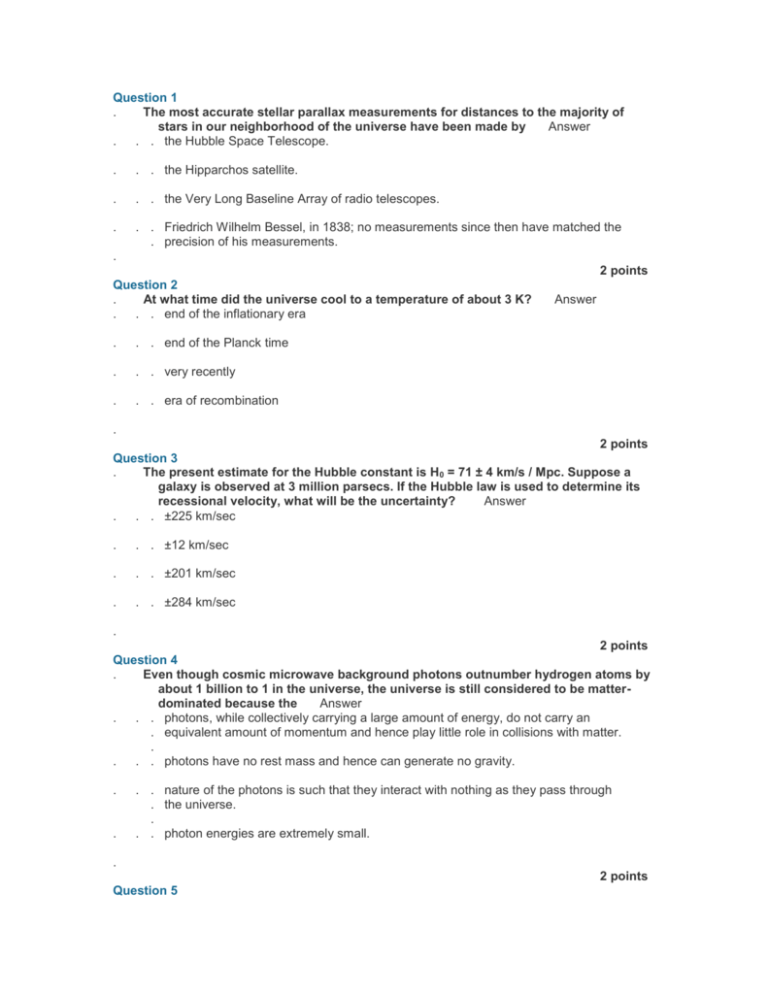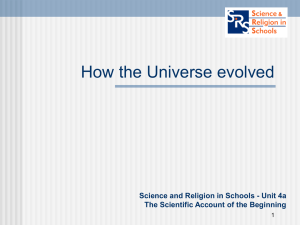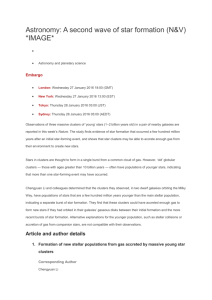midterm_3 - Homework Market
advertisement

Question 1 . The most accurate stellar parallax measurements for distances to the majority of stars in our neighborhood of the universe have been made by Answer . . 1. the Hubble Space Telescope. . . . 2. the Hipparchos satellite. . . . 3. the Very Long Baseline Array of radio telescopes. . . . 4. Friedrich Wilhelm Bessel, in 1838; no measurements since then have matched the . precision . of his measurements. . 2 points Question 2 . At what time did the universe cool to a temperature of about 3 K? Answer . . 1. end of the inflationary era . . . 2. end of the Planck time . . . 3. very recently . . . 4. era of recombination . . 2 points Question 3 . The present estimate for the Hubble constant is H0 = 71 ± 4 km/s / Mpc. Suppose a galaxy is observed at 3 million parsecs. If the Hubble law is used to determine its recessional velocity, what will be the uncertainty? Answer . . 1. ±225 km/sec . . . 2. ±12 km/sec . . . 3. ±201 km/sec . . . 4. ±284 km/sec . . 2 points Question 4 . Even though cosmic microwave background photons outnumber hydrogen atoms by about 1 billion to 1 in the universe, the universe is still considered to be matterdominated because the Answer . . 1. photons, while collectively carrying a large amount of energy, do not carry an . equivalent . amount of momentum and hence play little role in collisions with matter. . . . 2. photons have no rest mass and hence can generate no gravity. . . . 3. nature of the photons is such that they interact with nothing as they pass through . the. universe. . . . 4. photon energies are extremely small. . . 2 points Question 5 . The cosmological redshift of the light from very distant galaxies is caused by the Answer . . 1. expansion of space, stretching the photon's wavelength while the photon is traveling . toward . Earth. . . . 2. absorption of blue light by interstellar dust between the Earth and the galaxy so that . only . the red wavelengths reach the Earth. . . . 3. Doppler shift, in which the photon's wavelength is stretched by the galaxy's motion . through . space, away from Earth, while the photon is being emitted. . . . 4. rotation of the universe around its center (faster at greater distances from Earth). . . 2 points Question 6 . A supercluster of galaxies is a Answer . . 1. cluster of galaxy clusters. . . . 2. cluster of galaxies that is spread out over a larger than normal volume of space. . . . 3. cluster of galaxies that is packed much more densely than normal clusters, giving . it a. higher mass. . . . 4. phrase describing all the galaxies in the universe as a single system. . . 2 points Question 7 . Why would intelligent alien beings wanting to communicate with us probably choose the 21-cm atomic hydrogen radio wavelength? Answer . . 1. This radiation at this particular wavelength is very weak from natural sources in space, . and. messages would be easily distinguished from other sources. . . . 2. This wavelength shows a very strong Doppler effect when its source is moving, and . intelligent . alien beings would know that we would be able to detect the orbital motion . of their home planet around their star by this method. . . . 3. Intelligent alien beings would have detected this particular wavelength from our . transmitters . on Earth since it is used extensively for satellite communications, . and they would know that we could detect them easily. . . . 4. Intelligent alien beings would expect that many of our telescopes would already . be .tuned to this precise wavelength for scientific work. . 2 points Question 8 . Which nuclear fusion cycle is the next one to begin after helium fusion ends in a massive star? Answer . . 1. carbon fusion . . . 2. silicon fusion . . . 3. iron fusion . . . 4. oxygen fusion . . 2 points Question 9 . The first 10–43 s of the age of the universe, during which all four fundamental forces were united, is called the Answer . . 1. Hubble time. . . . 2. Planck era. . . . 3. inflationary era. . . . 4. event horizon. . . 2 points Question 10 . Doppler measurements of the motions of stars in nearby spiral and barred galaxies indicate that Answer . . 1. in most spiral and barred galaxies, the arms lead the rotation of the nucleus; that is, . the. arms spin faster than the nucleus. . . . 2. in most spiral and barred galaxies, the arms trail behind the rotating nucleus. . . . 3. in most spiral and barred galaxies, the arms rotate ahead of the nucleus; i.e., spiral . and . barred galaxies are mostly leading-arm galaxies. . . . 4. about half of all galaxies have trailing arms—the stars rotate slower than the . nucleus—while . in the other half, the arms rotate ahead of the nucleus. . 2 points Question 11 . Why is it that we will not see fluctuations in light output in times shorter than about 1 day when we observe an extragalactic source whose diameter is about 1 light-day? Answer . . 1. Arrival times will be different from different parts of the source, which will smooth . out. short-term fluctuations. . . . 2. The light from different parts of the source will be Doppler-shifted by different . amounts, . allowing us to see only an average shift. . . . 3. Absorption of light by intergalactic matter will smooth out rapid fluctuations . within . the beam. . . . 4. It is inconceivable that a source of this size could vary on such short time scales. . . 2 points Question 12 . What is the Hubble classification for a spiral galaxy with a large nuclear region and tightly wound arms? Answer . . 1. Sc . . . 2. SBc . . . 3. Sb . . . 4. Sa . . 2 points Question 13 . The spectrum of an ordinary main-sequence star is a Answer . . 1. smooth continuum of color, peaking at a specific wavelength whose position . depends . on the star's surface temperature. . . . 2. continuum of colors crossed by dark absorption lines caused by absorption by . cooler . atoms and molecules at the star's surface. . . . 3. continuum of colors, crossed by brighter lines caused by emission from the hot . atoms . and molecules on the star's surface. . . . 4. series of emission lines, mostly from hydrogen, the major constituent of stellar . surfaces, . that occasionally overlap to produce sections of continous color. . 2 points Question 14 . The forces of gravity and electromagnetism are long-range forces, extending in principle from their source (mass and electric charge, respectively) to infinity. Why is it that, in the universe, only gravity extends to infinity, whereas electromagnetic forces are much more limited in extent? Answer . . 1. Gravity and electromagnetism are one and the same force, with electromagnetic . effects . extending over limited spatial ranges and transforming into gravitational . forces at large distances from matter. . . . 2. Electromagnetic forces from positive charges are canceled by negative charges, . whereas . there are no negative “masses” to cancel the gravitational force. . . . 3. All atoms are electrically neutral, so in reality the electromagnetic force never . reaches . beyond the size of an atomic nucleus. . . . 4. Electromagnetic forces from charged particles will move other charged particles . around . to produce a uniform charge distribution and therefore zero electromagnetic . forces, whereas gravity concentrates mass and enhances the overall gravity force. . 2 points Question 15 . Measurements suggest that light first arrived at Earth from the Cassiopeia A supernova about 300 years ago and that this supernova is about 10,000 ly distant from Earth. When did the explosion actually occur? Answer . . 1. It is not possible to determine when the explosion occurred from the information given. . . . 2. 300 years ago, or about A.D. 1700. . . . 3. 9700 years ago, or about 7700 B.C. . . . 4. 10,300 years ago, or about 8300 B.C. . . 2 points Question 16 . Astronomy with a radio telescope was initiated by Answer . . . . . 1. an amateur astronomer, Grote Reber, after Jansky had detected radio energy from . the. galaxy. . . 2. the British Broadcasting Corporation in England. . . 3. the National Radio Astronomical Observatories of the United States, with the . support . of the National Science Foundation and the American Astronomical Society. . . 4. Marconi in Europe. . . 2 points Question 17 . The Milky Way is an example of which type of galaxy? Answer . . 1. elliptical . . . 2. spiral . . . 3. irregular . . . 4. lenticular, S0 type . . 2 points Question 18 . Objects with masses between 13 and 75 times the mass of Jupiter do not fuse hydrogen but do fuse deuterium and lithium into helium. What do we call such objects? Answer . . 1. extrasolar planets . . . 2. sub-brown dwarfs . . . 3. red dwarfs . . . 4. brown dwarfs . . 2 points Question 19 . Evidence for the conclusion that the longer-living gamma-ray bursters are very distant comes from the Answer . . 1. delay in the arrival of the visible pulse behind the gamma-ray pulse, caused by . the. passage of the light through optically thick intergalactic material. . . . 2. spread in arrival times of different gamma-ray photon energies, indicating a . long . passage through intergalactic gas. . . . 3. presence of absorption lines from intergalactic gas clouds in the spectrum of . remnant . visible light following the gamma-ray burst. . . . 4. extreme redshift of emission lines in the visible spectrum detected after a . gamma-ray . burst. . 2 points Question 20 . An astronomer studying a distant galaxy finds that its recessional velocity is 14,000 . . . . . . . . km/s. What is the distance to the galaxy? Assume Hubble's constant to be 70 km/s per Mpc. Answer 1. 200 Mpc . 2. 980,000 Mpc . 3. 2000 Mpc . 4. 98 Mpc . . 2 points Question 21 . The Hubble flow, demonstrating the expansion of the universe, occurs Answer . . 1. between clusters of galaxies in superclusters and between superclusters over wider . ranges . of space. . . . 2. between stars in galaxies, galaxies in clusters, clusters in superclusters, and . superclusters . over wider regions of space. . . . 3. between galaxies in clusters, clusters in superclusters, and superclusters in wider . regions . of space. . . . 4. only between superclusters of galaxies. . . 2 points Question 22 . The Tully-Fisher relationship can be used to measure the luminosity of (and thus the distance to) Answer . . 1. spiral galaxies. . . . 2. globular clusters. . . . 3. elliptical galaxies. . . . 4. Type II supernovae. . . 2 points Question 23 . In modern particle physics, the proton and the neutron are now thought to be composed of more fundamental particles called Answer . . 1. neutrinos. . . . 2. photons. . . . 3. quarks. . . . 4. gluons. . . 2 points Question 24 . Which of the following speeds are described by Hubble's law? Answer . . 1. speeds of superclusters of galaxies . . . . . 2. speeds of individual clusters of galaxies in the Milky Way's local supercluster . . 3. speeds of stars in the Milky Way Galaxy . . 4. speeds of individual galaxies in the Local Group and other nearby galaxy clusters . . 2 points Question 25 . Stars in a binary system are useful in studying mass transfers because we know that the two stars have the same Answer . . 1. spectral type. . . . 2. age. . . . 3. mass. . . . 4. radius. . . 2 points Question 26 . Where do we find supermassive black holes? Answer . . 1. in the centers of both active and normal galaxies, both nearby and far away . . . 2. in the centers of both active and normal galaxies, but only those at relatively high . redshift . values, indicating that they existed in the distant past . . . 3. in the centers of giant elliptical galaxies . . . 4. in the centers of active galaxies . . 2 points Question 27 . The helium flash results from the Answer . . 1. electron degeneracy or quantum crowding in the core of a low-mass red giant star. . . . 2. sudden onset of nuclear reactions at the end of the protostar. . . . 3. high temperature in the helium core of a blue (spectral class O or B) supergiant star. . . . 4. sudden release of energy in strong magnetic fields near a sunspot. . . 2 points Question 28 . Why is flatness a problem in cosmology? Answer . . 1. The total amount of known matter (even if we include dark matter) is not enough . to make . the universe flat. . . . 2. The universe appears to have a hyperbolic geometry to within observational error, . yet.the universe is expanding, and expanding universes have to be flat. . . . 3. Matter is known to create bumps in the geometry of spacetime; therefore, the . . universe . cannot be flat. . . 4. The universe appears to be flat to within observational error, yet the universe is . expanding, . and it is impossible for an expanding universe to be flat. . 2 points Question 29 . What name is given to a galaxy with a smooth distribution of brightness and a round shape? Answer . . 1. E0 . . . 2. SBa . . . 3. E7 . . . 4. Sa . . 2 points Question 30 . An electromagnetic wave leaves the surface of a neutron star and travels outward. As the wave gets farther from the star's surface, the _____ and the _____. Answer . . 1. speed decreases; frequency decreases . . . 2. speed decreases; wavelength increases . . . 3. frequency decreases; wavelength increases . . . 4. frequency increases; wavelength decreases . . 2 points Question 31 . In the 1970s it was discovered that, among spiral galaxies, the wider the 21-cm radio emission line, the brighter is the galaxy. What is the name of this relation? Answer . . 1. mass-luminosity law . . . 2. Hawking effect . . . 3. Tully-Fisher relation . . . 4. Hubble law . . 2 points Question 32 . For which one of the following objects has the phenomenon of differential rotation NOT been observed? Answer . . 1. Sun . . . 2. Mars . . . 3. Milky Way Galaxy . . . 4. Jupiter . . 2 points Question 33 . A planetary nebula is created Answer . . 1. over several hundred years, during mass transfer in a close binary star system. . . . 2. in hours or less, during the explosion of a massive star. . . . 3. over a few thousand years or more, in a slow expansion away from a low-mass star, . driven . by a series of thermal pulses from helium fusion. . . . 4. in seconds, during the helium flash in a low-mass star. . . 2 points Question 34 . What is the most outstanding feature of a quasar compared with other objects in deep space? Answer . . 1. great distance from Earth . . . 2. prodigious output of energy . . . 3. small size . . . 4. short lifetime . . 2 points Question 35 . Quasars emit significant amounts of radiation from the Lymanα transition. When the spectrum is observed on Earth, it is found that the Lymanα line is accompanied by many absorption lines, called the Lymanα forest. What is the origin of these lines? (See Figure 17-5, Comins and Kaufmann, Discovering the Universe, 8th ed.) Answer . . 1. The absorption lines are caused by the rotation of the quasar. Different parts of . the. quasar thus give rise to Lyman-alpha lines with different Doppler shifts. . . . 2. Because the quasar's jets are aimed at various directions, the jet plasma has Doppler . shifts . that are different from those of the quasar itself. The result is a variety of . Lyman-alpha wavelengths in the spectrum received on Earth. . . . 3. The absorption lines are the result of gravitational lensing by objects between the . quasar . and Earth. . . . 4. The emitted Lyman-alpha radiation is absorbed by many gas clouds between the . quasar . and Earth. The lines are receding at various velocities and thus are absorbed . at different Doppler-shifted wavelengths. . 2 points Question 36 . In a binary star system, an unseen component is found to have 8 solar masses. It would be visible if the system were a normal star, so it must be a collapsed object. Theoretical considerations tell us that it must be a Answer . . 1. white dwarf. . . . . . 2. neutron star. . . 3. brown dwarf. . . 4. black hole. . . 2 points Question 37 . Why is the Coma cluster of galaxies a favorite among astronomers? Answer . . 1. The Coma cluster is the cluster in which the Milky Way Galaxy is situated. . . . 2. The Coma cluster is the rich, regular cluster nearest the Earth. . . . 3. The Coma cluster contains two quasars. . . . 4. The Coma cluster is the rich, irregular cluster nearest the Earth. . . 2 points Question 38 . In terms of the evolutionary life of a star, at what stage is the Crab Nebula? Answer . . 1. middle-age: main-sequence star, relatively near the Sun . . . 2. black hole: very late stage of evolution . . . 3. late: it is the remnant of a star explosion or supernova . . . 4. beginning: nebula in which stars are forming . . 2 points Question 39 . A particular galaxy appears round, with a nuclear region of uniform brightness and an outer region that is broken up into long, curved, well-defined lanes of stars and light gas clouds. How would this galaxy be classified? Answer . . 1. irregular . . . 2. flocculent spiral . . . 3. elliptical . . . 4. grand-design spiral . . 2 points Question 40 . The “star” that is seen at the center of a planetary nebula is Answer . . 1. a planet in the process of formation. . . . 2. the accretion disk around a black hole. . . . 3. composed almost entirely of neutrons and spinning rapidly. . . . 4. a small, hot, and very dense white dwarf star. . . 2 points Question 41 . The cosmological redshift in the light from distant galaxies is explained by which of the following effects? Answer . . 1. The light from more distant galaxies has traveled through the gravitational fields . of more . galaxies in getting to us and is therefore more gravitationally redshifted. . . . 2. A photon's wavelength is a distance and is therefore lengthened by the general . expansion . of the universe, making the light appear reddened. . . . 3. The light spreads out over larger areas as distance increases according to 1/(distance) 2, . which . causes the wavelength to increase in proportion to distance. . . . 4. The light we on Earth see was Doppler-shifted to longer wavelengths by the motion of . the. objects (e.g., galaxies) away from Earth. . 2 points Question 42 . The first accurate measurement of stellar parallax was made in Answer . . 1. 1927. . . . 2. 1721. . . . 3. the fourth century B.C. . . . 4. 1838. . . 2 points Question 43 . What fraction of the mass of the Milky Way Galaxy appears to be in the form of “dark matter,” which we cannot see but can detect through its gravitational influence? Answer . . 1. about 10% . . . 2. about 90% . . . 3. about 50% . . . 4. 0%—who ever heard of matter that can't be seen? . . 2 points Question 44 . If a distant cluster were to be composed only of stars with apparent magnitude of +3, how many stars would there be in this cluster if its apparent magnitude matched that of a star with apparent magnitude of +1? Answer . . 1. 102, or 100 . . . 2. 2 . . . 3. about 2.5 . . . 4. between 6 and 7 . . 2 points Question 45 . Which of the following facts referring to stars in a cluster is NOT particularly useful for interpreting the evolution of these stars? Answer . . 1. The stars formed from the same mix of chemical elements but with a mix of original . masses. . . . . 2. The stars all formed at about the same time. . . . 3. The majority of the material in these stars is hydrogen. . . . 4. The stars are all at the same distance from the Earth, so we measure true intrinsic . brightnesses . of the stars. . 2 points Question 46 . Gas jets have often formed perpendicular to the plane of the accretion disk around a black hole or a neutron star. What propels the gas away from the hole or star? Answer . . 1. enormous pressure of the compressed infalling gas of the accretion disk . . . 2. strong curvature of spacetime near the object . . . 3. conservation of momentum since the outgoing particles are pair-produced . as .virtual particles near the object . . . 4. magnetic forces from the object's strong magnetic field . . 2 points Question 47 . The energy required to ionize the hydrogen gas in an emission nebula (H II region) comes from Answer . . 1. UV emission from hot O and B stars. . . . 2. collisions between gas clouds in interstellar space. . . . 3. T Tauri stars. . . . 4. supernovae (exploding stars). . . 2 points Question 48 . Two stars have the same luminosity (or absolute magnitude). One star is spectral class F and the other is spectral class K. From this information, we know that the Answer . . 1. B-type star is larger than the K-type star. . . . 2. K-type star is hotter but can be larger, smaller, or the same size as the B-type star. . . . 3. B-type star is hotter but can be larger, smaller, or the same size as the K-type star. . . . 4. K-type star is larger than the B-type star. . . 2 points Question 49 . The bright stars at the center of an emission nebula (H II region) are Answer . . 1. red supergiants. . . . 2. hot white dwarfs. . . . 3. young O and B stars. . . . 4. T Tauri stars. . . 2 points Question 50 . Which of the following spectral classification letters signifies the hottest stellar surface temperature? Answer . . 1. G . . . 2. B . . . 3. A . . . 4. K .









